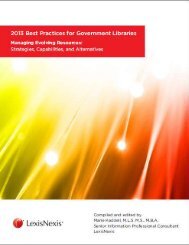2012 Best Practices for Government Libraries
2012 Best Practices for Government Libraries
2012 Best Practices for Government Libraries
Create successful ePaper yourself
Turn your PDF publications into a flip-book with our unique Google optimized e-Paper software.
Open <strong>Government</strong>: Digitization and In<strong>for</strong>mation Sharing<br />
134<br />
BEST PRACTICES <strong>2012</strong><br />
By Joanne She, Coordinator of Digitization Services, U.S. Department of Justice and Tina<br />
Smith, Reference Librarian, U.S. Department of Justice<br />
INTRODUCTION<br />
“Open <strong>Government</strong>” has been a strong public interest and a great government concern <strong>for</strong><br />
a long time. Back in 1966, Congress passed the first Freedom of In<strong>for</strong>mation Act (FOIA),<br />
and since then, this law has been significantly revised several times, and many related<br />
laws have been passed as well. On December 31, 2007, President George W. Bush signed<br />
the OPEN <strong>Government</strong> Act of 2007 [1] into law and pushed an E-government movement.<br />
Once President Obama took office, his first step was making open government a high<br />
priority.” 1 Three years have passed since then, and based on our observations, we think<br />
that the Open <strong>Government</strong> Policy has actually led a to vital digitization movement in the<br />
government, and that this digitization is re<strong>for</strong>ming the government and enhancing<br />
in<strong>for</strong>mation sharing.<br />
DECLASSIFICATION MOVEMENT<br />
The first strategy of the Open <strong>Government</strong> plan is massive disclosure of government<br />
in<strong>for</strong>mation. One of the major focuses of E.O.13526[2] is declassifying more government<br />
in<strong>for</strong>mation automatically and systematically. It directed all agencies to review their<br />
classification guidelines and ensure that all delegations of original classification authority<br />
are limited to the minimum necessary, and to develop a plan implementing the new<br />
provisions into their daily procedures in final <strong>for</strong>m within 180 days. 2 This step has led to<br />
massive disclosure of in<strong>for</strong>mation and more government documents open to the public<br />
once they are declassified. According to the 2010 Report to the President, 3 federal<br />
agencies declassified more than 29 million pages last year. The chart below shows a<br />
breakdown of this declassification activity.<br />
Table 1: Declassification of Major Federal Agencies, FY 2010 (Data taken from<br />
pp.16-18 of 2010 Report)<br />
1 White House. Transparency and Open <strong>Government</strong>. Accessed January 3, <strong>2012</strong>:<br />
http://www.whitehouse.gov/the_press_office/TransparencyandOpen<strong>Government</strong><br />
2 Obama, B. Executive Order 13526- Classified National Security In<strong>for</strong>mation. December 29, 2009.<br />
Section 6.3. Retrieved January 3, <strong>2012</strong>, from the White House: http://www.whitehouse.gov/thepress-office/executive-order-classified-national-security-in<strong>for</strong>mation<br />
3 National Archives and Records Administration, In<strong>for</strong>mation Security Oversight Office. 2010 Report<br />
to the President. April 15, 2011. Page 1. Retrieved January 4, <strong>2012</strong>, from NARA:<br />
http://www.archives.gov/isoo/reports/2010-annual-report.pdf



